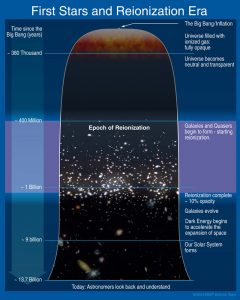 De acuerdo al modelo cosmológico estándar, el Universo se enfría desde un estado de altísima temperatura, en el que los constituyentes de la materia se encuentran en su forma más elemental. Recién al bajar la temperatura por debajo de aproximadamente 10.000 K, pueden recombinarse protones y electrones para formar átomos neutros. Esto ocurrió 0.4 Myr después del Big Bang, momento en que se produce el fondo de radiación de microondas, y que da origen a la llamada «Edad Oscura». Esta etapa termina entre 0.4 y 1 Gyr después del Big Bang, instante en que se observa que el medio que llena el Universo se encuentra nuevamente ionizado. Las causas y el desarrollo de esta transición de fase, llamada Reionización del Universo, son aún tema de debate. Si bien el consenso indica que las primeras fuentes luminosas (estrellas y sistemas estelares) serían las responsables de inyectar energía al medio para ionizarlo, la contribución de cada tipo de fuente y el detalle del proceso no se conocen aún. El estudio de este problema requiere a la vez de poderosas herramientas de simulación numerica para predecir las características del fenómeno, y de modernos observatorios radioastronómicos como el Square Kilometer Array para detectar la emisión en la longitud de onda de 21 cm, del hidrógeno neutro situado a distancias de miles de millones de parsecs.
De acuerdo al modelo cosmológico estándar, el Universo se enfría desde un estado de altísima temperatura, en el que los constituyentes de la materia se encuentran en su forma más elemental. Recién al bajar la temperatura por debajo de aproximadamente 10.000 K, pueden recombinarse protones y electrones para formar átomos neutros. Esto ocurrió 0.4 Myr después del Big Bang, momento en que se produce el fondo de radiación de microondas, y que da origen a la llamada «Edad Oscura». Esta etapa termina entre 0.4 y 1 Gyr después del Big Bang, instante en que se observa que el medio que llena el Universo se encuentra nuevamente ionizado. Las causas y el desarrollo de esta transición de fase, llamada Reionización del Universo, son aún tema de debate. Si bien el consenso indica que las primeras fuentes luminosas (estrellas y sistemas estelares) serían las responsables de inyectar energía al medio para ionizarlo, la contribución de cada tipo de fuente y el detalle del proceso no se conocen aún. El estudio de este problema requiere a la vez de poderosas herramientas de simulación numerica para predecir las características del fenómeno, y de modernos observatorios radioastronómicos como el Square Kilometer Array para detectar la emisión en la longitud de onda de 21 cm, del hidrógeno neutro situado a distancias de miles de millones de parsecs.
Cosmology
According to the standard cosmological model, the Universe cools from a state of very high temperature, in which the matter is in the form of elementary particles. As soon as the temperature drops below approximately 10.000 K, protons and electrons can recombine to form neutral atoms. This happened 0.4 Myr after the Big Bang, when the Cosmic Microwave Background is formed, and the so called «Dark Ages» begin. This stage ends between 0.4 and 1 Gyr after the Big Bang, when observations show that the medium pervading the Universe is ionized once again. The causes and the development of this phase transition, called «Epoch of Reionization», are still under debate. Although it is commonly accepted that the first light sources (stars and stellar systems) are responsible for the injection of energy to the medium to ionize it, the contribution of each type of sources and the details of the process are still unknown. The investigation of this problem requires both powerful numerical simulation tools to predict the characteristics of this phenomenon, and modern radioastronomical facilities such as the Square Kilometer Array to detect the emission at 21 cm wavelength, of neutral hydrogen lying billions of parsecs away.
